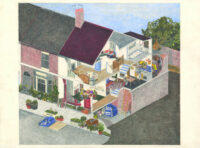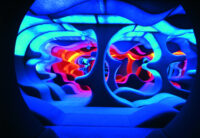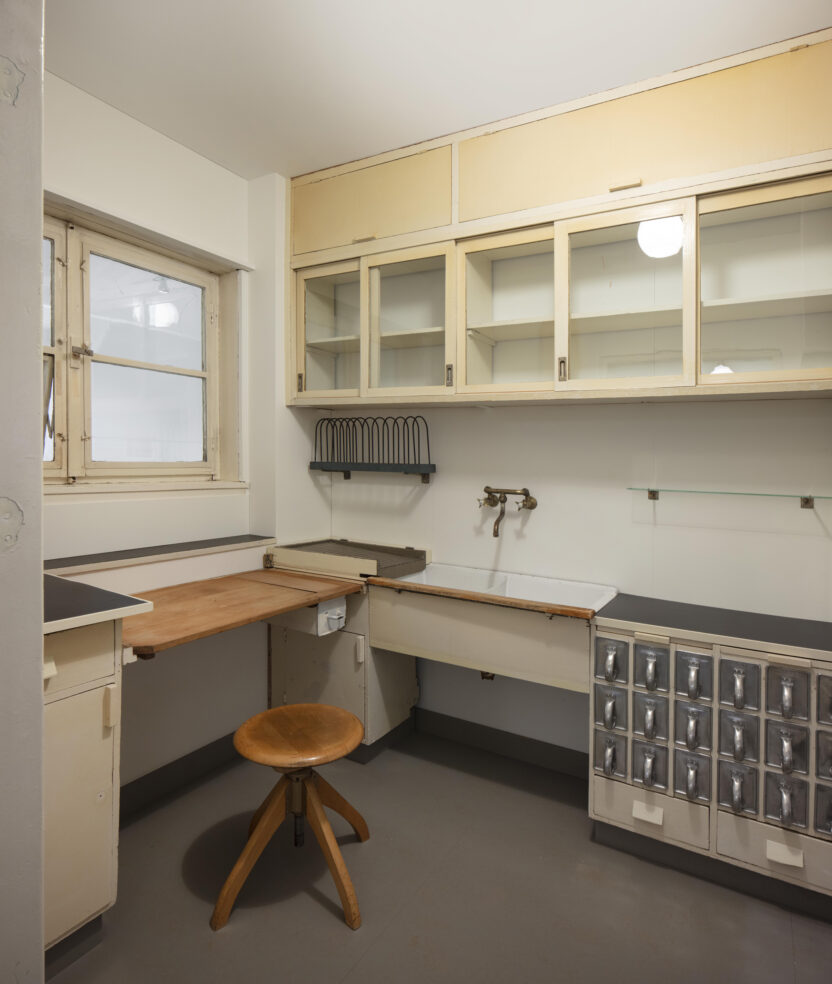
Home Stories
100 Years, 20 Visionary Interiors
Our homes are an expression of the way we live, they shape our everyday routines and fundamentally affect our well-being. This has been proven to be true more than ever in the last year. Our home has become a place of refuge – somewhat against our will for some. Ambitious aesthetics contrast with practical considerations. How can we reconcile working and living? How can schoolchildren study at home? How can we ensure privacy when space is limited?

A new debate about the private interior, its history and its future perspectives is urgent. With Home Stories. 100 Years, 20 Visionary Interiors the museum aims to do just that. In a captivating narrative leading visitors backwards in time, the exhibition will highlight important societal, political, urban and technical shifts that have shaped the design and the use of the Western interior over the last 100 years.
From current issues facing the domestic domain – such as the efficient use of dwindling urban space to the blurring of work-life boundaries – the journey goes on to our fascination with loft-living in the 1970s, the shift from formal to informal dwelling in the 1960s, the rise of household appliances in the 1950s and the introduction of open-space planning in the 1920s. The exhibition is organised around 20 iconic interiors by architects such as Verner Panton, Finn Juhl, Lina Bo Bardi and Assemble; artists like Andy Warhol or Cecil Beaton, as well as interior designer Elsie de Wolfe.
“We’ve seen an interest in domestic interior design as a discipline for some time, yet it seems to have lacked a serious discourse until now. It’s mainly dealt with in superficial ways: in glossy magazines, television programming and social media. We wanted to show important historical examples as an inspiration for a more serious discussion.”
Jochen Eisenbrand, curator
In presenting iconic interiors as well as examples that are not universally known, Home Stories wants to reignite the fundamental discourse about the discipline of interior design. All 20 case studies are exemplary for broader design trends or developments in history. These interiors are deliberately not recreated. Too many elements that make up an interior like room heights, the incidence of daylight and the transition between inside and outside, can simply not be duplicated. Instead, Home Stories depicts the case studies in images, films, furniture, sketches, models and mood boards.
This sumptuous range of exhibits reveals interior design as a discipline full of surprises and variety. Throughout the four parts of the exhibition visitors go back and forth between standardisation, functionalism, and formal reduction on the one hand to individualisation and ornamentation on the other. An overview that raises a key question in our modern society: how do we want to live?

Space, Economy and Atmosphere: 2000 – Today

The exhibition starts with a look at a few selected contemporary interiors which reflect the radical shifts in private interiors that we are currently experiencing. As an answer to rising property prices and the resulting shortage of affordable living space, micro-housing design utilises built-in and convertible furniture. This can be seen in Yojigen Poketto (which translates to 4D pocket), an apartment designed by the architecture studio Elii in Madrid (2017). At the same time, innovative conversion projects, such as Arno Brandlhuber’s Antivilla near Berlin (2014) – which uses textiles as movable space dividers – offer strategies for efficiently optimising space and reflect a new definition of comfort and luxury which is based on simplicity and the language of material. Another societal change which is reflected in interior design is the increasing relevance of the sharing economy. One example for this is the project Granby Four Streets Community Housing in Liverpool (2013 – 17). A group of residents, who formed a Community Land Trust, started the project and brought in the multidisciplinary collective Assemble. Together they saved a Victorian terrace of houses from urban decay, gutted and redesigned the interiors for contemporary needs and helped establish a workshop that reuses building materials to create furnishings for the new spaces.
Internet platforms like Airbnb, Instagram and Pinterest have all fuelled the perception of the private interior as a commodity that can be displayed and capitalised at any moment. However, the imagery and display strategies in many private interiors today can still be traced back to pre-modern or even vernacular dwelling traditions. This can be seen in a slideshow by Jasper Morrison exclusively commissioned for the exhibition, which explores how the arrangement of objects fundamentally affects the character and the atmosphere of a private space.

Marie Jacotey, Granby N48 (drawing of the housing project Granby Four Streets by Assemble, Liverpool, UK, 2013-today), 2016. Courtesy of the artist and Hannah Barry Gallery, London
Rethinking the Interior: 1960 – 1980

The second section of the exhibition looks at the radical shifts in interior design from the 1960s to the 1980s. With the spread of postmodernism, designers began to reflect on the symbolic meaning of furnishings, patterns and decorations, most famously embodied in the works of the design group Memphis. A passionate collector of Memphis designs, fashion designer Karl Lagerfeld turned his apartment in Monte Carlo into a postmodern Memphis showroom in the early 1980s. During the two previous decades, the era’s general social upheavals were reflected in the private interior. In collaboration with philosopher Paul Virilio, architect Claude Parent introduced the concept of ‘the oblique’ to interiors to counter the predominant neutral, cube-like spaces prevalent at the time. Parent furnished his own apartment in Neuilly-sur-Seine, France (1973) with built-in, multifunctional inclined planes that could serve interchangeably as seating, dining or workspace, or a daybed. Andy Warhol’s New York Silver Factory (1964 – 67) evolved as a prime example of early loft-living and became an almost mythical symbol of the artist’s studio as an ideal combination of living and workspace.
At the same time, the furniture manufacturer and retail company IKEA was set to revolutionise the industry with its agenda of providing modern furniture to the masses. IKEA’s rise to becoming the world’s largest furniture manufacturer and retailer has contributed to the ground-breaking shift in how we perceive furniture now — from an object that is passed on from generation to generation, to the short-lived, disposable and rapidly superseded consumer product it is today.
Verner Panton’s legendary Fantasy Landscape (1970) is the central piece in the exhibition, representing the radical ideas of 1960s and ’70s interior design. Visitors can access the cave-like tunnel decked in luscious shades of violet and blue with a glowing centre of red, orange and yellow and fully experience the atmosphere.

Nature and Technology: 1940 – 1960

Another decisive era in the formation of the modern interior were the post-war years, when the modern interior design style that had been developed before World War II entered the domestic realm of an increasing number of people in the Western world. During the Cold War, the political competition between East and West crystallised around the question of living standards, culminating in the famous Kitchen Debate between Richard Nixon and Nikita Khrushchev that took place in an American prefabricated house displayed in Moscow in 1959. Leading up to this, the mid-twentieth century saw the language of the modern interior become more refined, and approaches to interior design emerged that are still relevant today. The House of the Future designed by Peter and Alison Smithson for the Ideal Home Exhibition in London in 1956 embraced prefabrication methods and household automation, including the latest kitchen appliances and a self-cleaning bath. Much more sceptical of technological progress and functionalist design, Jacques Tati staged the Villa Arpel in his film Mon Oncle (1958) as an aseptic home with a mind of its own, dominating its inhabitants.
By combining modern forms and materials with a feeling of ‘homeliness’, Scandinavian interiors became increasingly influential around the world, as exemplified by the private residence of architect Finn Juhl and his house in Ordrup, Denmark (1942). Juhl used his own home to test the furniture he designed, to explore how it would work as part of an interior. Moreover, ‘living with nature’ and the ‘fluid boundaries’ between indoors and outdoors became key topics for architects like Lina Bo Bardi and her Casa de Vidro in São Paolo, Brazil (1950 – 51). Bernard Rudofsky, another architect to contemplate the relationship between the private dwelling and its natural surroundings, took inspiration from vernacular building traditions to promote houses with outdoor rooms. Together with the artist Costantino Nivola he created an outdoor living space known as Nivola House-Garden in Long Island, New York (1950).
The Birth of the Modern Interior: 1920 – 1940

Frankfurter Kitchen © Vitra Design Museum, Photo: Ludger Paffrath
The 1920s and ’30s saw the emergence of several key concepts of domestic space and interior decoration that still dominate our interiors today. In these early years of modern design, much different from today, the private interior stood at the centre of architectural debate. This is exemplified on a very large scale by the public housing programme Das Neue Frankfurt (1925 – 30). Directed by architect Ernst May it included not only the famous Frankfurt kitchen by Margarete Schütte Lihotzky (1926) but also affordable furniture designed by Ferdinand Kramer and Adolf Schuster. While May pursued a strong social agenda, other architects radically reinvented the distribution and versatility of domestic space. In his Villa Tugendhat in Brno, Czech Republic (1928 – 30), Ludwig Mies van der Rohe created one of the first houses based on an open-plan concept, with fluid spaces in which carefully placed furnishings and textiles created islands for different uses. Adolf Loos advocated the ‘Raumplan’, a concept of spatial planning that could not be understood in two dimensions because of its three-dimensional complexity. His Villa Müller in Prague (1929 – 30) features a carefully choreographed sequence of spaces at different levels and of different heights, which exceed the standard notion of single-plane floors. Fellow Austrian, architect and product designer Josef Frank introduced the concept of ‘accidentism’, whereby interiors would grow organically over time and look as if composed by chance.
Contrary to these modernist positions some of their contemporaries embraced ornamentation as a means of expression. Elsie de Wolfe, who published her book The House in Good Taste in 1913, is often regarded as one of the first professional interior decorators. De Wolfe advocated the interior as a representation of the identity of the person living in it. This was also true for the interiors created by photographer and interior designer Cecil Beaton who used his domestic settings as a means of self-expression. For his Ashcombe House (1930 – 45) he drew inspiration from the arts, the theatre and even the circus.
Publication
The comprehensive publication published in conjunction with the exhibition explores these case studies as key moments in the history of the modern interior. It includes historic and recent photographs, drawings and plans.
Penny Sparke provides a concise history of the discipline of interior design, Alice Rawsthorn investigates the role of gender, and Mark Taylor discusses the discourse on interior design in the twenty-first century. Adam Štěch offers insights into the use of colour in residential interiors and Matteo Pirola offers a detailed and richly illustrated chronology of significant events in the history of interior design. In a portfolio of photographs selected exclusively for this book, Jasper Morrison explores what makes a good interior. In addition to interviews with contemporary interior design practitioners, experts in the fields of the sociology of living and psychology provide further insight. This book a valuable resource for anyone interested in interior design.

Home Stories 100 Years, 20 Visionary Interiors. Editors: Mateo Kries, Jochen Eisenbrand. 25 × 25,5 cm. 320 pages, approx. 500 images. ISBN: 978-3-945852-38-5 € 59,90.
Visiting information
Home Stories. 100 Years, 20 Visionary Interiors
27.03.2021 – 12.09.2021
Admission: € 10 | € 8 | € 6 | € 2 | € 0
Open on weekdays from 9:30 until 17:30
Open on weekends, on public holidays and during school holidays from 10:00 until 18:00
Closed on Wednesday
Sandra Plasschaert
Cats Communication
Press & PR
+32 479 35 10 39
sandra@catscommunication.be
Simon Adriaensen
Design Museum Gent
Communication
+32 9 323 64 88
simon.adriaensen@stad.gent